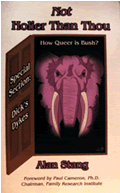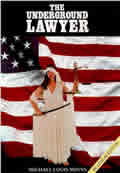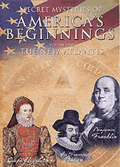SHERMAN: RACIST, TERRORIST, MONSTER
by
Alan Stang
June 5, 2009
NewsWithViews.com
[Announcement: Did you know Alan Stang has a new radio show? Click here for details.]
In our last piece, we saw that what Union forces conducted in the South was not just a war but a reign of terror. The man who conducted that terror was General William T. Sherman. The only thing most Americans brainwashed in government schools know about Sherman is his comment, “War is hell,” which creates the utterly spurious impression that he hated war.
What do we know about General Sherman? Our source for this discussion is Michael Fellman’s Citizen Sherman (New York, Random House, 1995). It is an ideal source for two reasons. First, Fellman is a Canadian, and therefore once removed from the partiality that bedevils Americans. Second, his book is not at all an exposé. Michael Fellman admires Sherman.
Let’s begin with Sherman’s attitude towards slavery and blacks: “Sherman simply was indifferent to any moral dimension of the slavery issue in large part because he did not see Negroes as humans.” Were you taught this in school?
In December, 1859, Sherman wrote, “I would not if I could abolish or modify slavery. . . . Negros (sic) in the great numbers that exist here must of necessity be slaves.” To his wife, he wrote, “Like Burton in ‘Toodles’ I say, ‘damn the niggers.’ . . .” These were by no means drunken aberrations, but lifelong bedrock beliefs.
In like fashion, Sherman denigrated Jews: Fellman speaks of “his assumptions about the inferiority of the whole race of blacks that fitted them for slavery. This racialism was in large part replicated . . . in Sherman’s opinions of the Jews. He blamed the war on blacks as he blamed it on Jews. . . .”
In a letter to his wife, on August 20, 1862, he wrote, “The cause of the war is not alone in the nigger, but in the mercenary spirit of our countrymen.” Fellman explains: “For Sherman, the personification of this evil mercenary spirit was the speculator, and the speculator was the Jew.”
Drenched in so much racist garbage, you will probably not be surprised to learn that Sherman could have been insane. During the war, friendly biographer Fellman writes, “. . . Sherman could neither run a theater of command nor hold himself together. He fell into what we would now consider a clinical depression, and on November 9 was removed from command in disgrace. This catastrophe and its aftermath were the nadir of Sherman’s career and of his life.”
Like his racism, Sherman’s madness was not an aberration. Later, he spent considerable time with New York journalist William G. Shanks. “. . . Sherman simply never sat still, Shanks wrote. His fingers were always busy, ‘twitching his red whiskers – his coat buttons – playing a tattoo on the table – or running through his hair.’ While sitting he would cross and uncross his legs continuously. And on and on he talked, nervously and obsessively. ‘He must talk quick, sharp . . . making his odd gestures which . . . emphasize his language. He never hesitates at interrupting anyone, but he cannot bear to be interrupted himself.’ . . .”
Mrs. Sherman rushed to his side, “knowing insanity to be in the family.” She was “tortured by fears,” which “have been only in part relieved since I got here.” He had written “that he felt he might be crazy, which was rather more confirmed than refuted by the other evidence she had discovered in Louisville.” He ate and slept rarely. Worse, “he seemed to have lost normal human contact with those around him on his staff.” He was obsessive and delusional.
“. . . She also noted a prior bout of depression in 1856-57, in California, to which she might have added his bitterly unhappy stay in Kansas in 1858-59 . . . . Sherman had at least one later episode of depression, in 1878, and one of his sons became a deeply depressive adult.” Finally, friendly biographer Fellman calls Sherman a “madman.”
This is the madman who conducted the literal reign of terror described in my companion piece, “Yankee Genocide: Still Here.” Fellman calls him an “enormous terrorist.” Toward the end of the war, he wrote his wife, “. . . I find myself a leader to whom not only my soldiers look to but the President and the People. Not only our own, but foreigners and the South now accord me one of the Great Leaders of armies, endowed with extraordinary qualities.” It was up and down all the way, from the slough of despond to Great Leader.
What kind of war did this lunatic wage? Fellman says it was “a prolonged war of purposeful terror.” The terror was “an intentional policy and not just a lack of control. . . . This madman and his swarming bummers seemed to have no implicit limits . . . .” So Sherman destroyed the modern concept of humane war that spares civilians and replaced it with the Communist idea of scorched earth. The thought is not fanciful. Historically terrorism is perpetrated by governments. Soviet dictator Lenin is supposed to have said that, at bottom, “Communism is terror.”
At war’s end, Sherman was still not finished. Now he set out to exterminate the Plains Indians. The word “extermination” is not inapt. He used it himself again and again. “We must act with vindictive earnestness against the Sioux, even to their extermination, men, women and children.”
Here is how Sherman conducted his campaign of extermination. “Although Sherman had not ordered an extermination campaign in so many words, he had given [General Phil] Sheridan prior authorization to slaughter as many women and children as well as men Sheridan or his subordinates felt was necessary when they attacked Indian villages. However many they killed, Sherman would cover the political and media front. They were freed to do anything. At the same time, Sherman maintained personal deniability—he could assert in any public forum that he had not ordered any atrocities that might occur. . . .”
Very clever for a crazy man, right? So we are talking about a homicidal lunatic, who endured uncharacteristic bouts of sanity. What do we know about Sherman’s personal life? No biographical sketch would be complete without some discussion of Sherman’s womanizing. What? Womanizing? In the middle of all that killing?
Your incredulity is logical. The ordinary man couldn’t do it. But, remember, we are not talking about an ordinary man. We are talking about Great Leader, the war chief, “charming, witty, energetic, and aggressive,” swarmed by women wherever he went. Fellman writes:
“. . . One does not know how many women he chased, or the number of his conquests – Victorian codes of seduction were deliberately cloaked with ambiguity, and the archival record is far from complete in such matters – but judging by the available evidence Sherman must have been a very energetic womanizer.”
Here is an example of Great Leader at work: “. . . Marszalek quotes the unpublished memoir of Mildred Hazen Dewey, who when the young wife of General William B. Hazen, one of Sherman’s former division commanders, found Sherman’s advances . . . quite aggressive. At one party the general backed her into a corner until she finally ‘called a halt.’”
Some of you, world weary and cynical, may now be thinking, okay, so he was a womanizer. So what? Eisenhower diddled Kay Sommersby. Jack Kennedy diddled Fiddle and Faddle. Billy Bubba Slime Diddled God knows what. But Ike probably didn’t go out of his way to rub Mamie’s face in Kay. Jack probably didn’t rub Jackie’s face in Fiddle. Here is how Great Leader did it:
“The more he thought of bringing Mary to St. Louis, the more aroused Sherman became. On December 18, 1883, he wrote her in the role of the ancient Greek kidnapper that he was coming to Washington on January 16, ‘ready to carry you bodily (willingly if possible – violently if necessary) to St. Louis, Missouri, where your friends demand your presence.’ . . . ‘You can have the guest room right over my office and though somewhat jealous of my rights, I think I will let you have pretty free range of my sanctum’ – his private dayroom and bedroom. He planned to bring his mistress to his bed right under his despised wife’s nose, passing her off as a friend of his wife and daughters.”
Is that world class panache, or what? Wife Ellen on one floor, Mistress Mary on another; so that unlike your ordinary womanizer, Sherman never had to sneak out, never had to concoct a cover story. Whatever his mood, he would go to the appropriate floor. Of course, only a Great Leader could pull it off.
|
Subscribe to the NewsWithViews Daily News Alerts! |
This is the monster who ran Lincoln’s Communist war to destroy the Union. This is how we got where we are. Indeed, the reason his story is so relevant today is that the men who now control America have the very same mentality – the same lunatic, consuming hubris – and they are doing the same things.
[Announcement: Alan Stang's radio show, The Sting of Stang, airs from 11 a.m. to 1 p.m. Central, M-F, via Republic Broadcasting Network. Call him on the air at (800) 313-9443. To listen, go to republicbroadcasting.org and click on Listen Live. If you can't listen at that time, do so via the archives. I'll be talking about the various manifestations of the conspiracy for world government, its tactics, such as the illegal alien invasion, its purposes and its players, from Jorge W. Boosh on down.]
� 2009 Alan Stang - All Rights Reserved










 Share This Article
Share This Article




